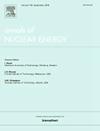Representation of homogenized cross section data by Canonical-Polyadic decomposition
IF 1.9
3区 工程技术
Q1 NUCLEAR SCIENCE & TECHNOLOGY
引用次数: 0
Abstract
In this paper, the tensor Canonical-Polyadic (CP) decomposition method is applied to represent few-group homogenized cross sections. The results of the method are analyzed when applied to two assemblies typical of VVER reactor (in Russian Vodo-Vodyanoi Energetichesky Reaktor meaning Water-Water Power Reactor). In particular, the presented analysis focuses on the 22UA assembly, represented by a dataset of 2-group assembly-homogenized cross sections, and on the 430GO assembly, represented by a dataset of 20-group pin-by-pin homogenized cross sections. Both assemblies’ specifications are taken from the X2VVER benchmark.
Errors in microscopic and macroscopic cross sections, are evaluated to assess the accuracy of the method to reproduce reference few-group homogenized cross sections. Furthermore, the reactivity error as well the error on fission-production and on absorption rate distributions are discussed by two fictive simple 3-D colorset simulations to evaluate the impact of the reconstructed cross sections on reactor core simulations. Additionally, the potential effectiveness of incorporating the CP decomposition into standard two-step neutronics schemes is studied and analyzed to effectively take into account the thermal-hydraulics feedback during core simulations. Preliminary results demonstrate the capability of the method to sensibly reduce the data storage as well as the memory usage and the computational time during cross-sections’ update.
求助全文
约1分钟内获得全文
求助全文
来源期刊

Annals of Nuclear Energy
工程技术-核科学技术
CiteScore
4.30
自引率
21.10%
发文量
632
审稿时长
7.3 months
期刊介绍:
Annals of Nuclear Energy provides an international medium for the communication of original research, ideas and developments in all areas of the field of nuclear energy science and technology. Its scope embraces nuclear fuel reserves, fuel cycles and cost, materials, processing, system and component technology (fission only), design and optimization, direct conversion of nuclear energy sources, environmental control, reactor physics, heat transfer and fluid dynamics, structural analysis, fuel management, future developments, nuclear fuel and safety, nuclear aerosol, neutron physics, computer technology (both software and hardware), risk assessment, radioactive waste disposal and reactor thermal hydraulics. Papers submitted to Annals need to demonstrate a clear link to nuclear power generation/nuclear engineering. Papers which deal with pure nuclear physics, pure health physics, imaging, or attenuation and shielding properties of concretes and various geological materials are not within the scope of the journal. Also, papers that deal with policy or economics are not within the scope of the journal.
 求助内容:
求助内容: 应助结果提醒方式:
应助结果提醒方式:


